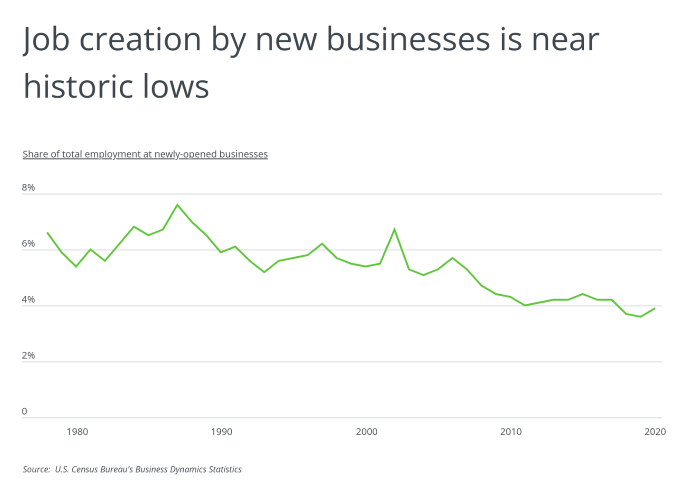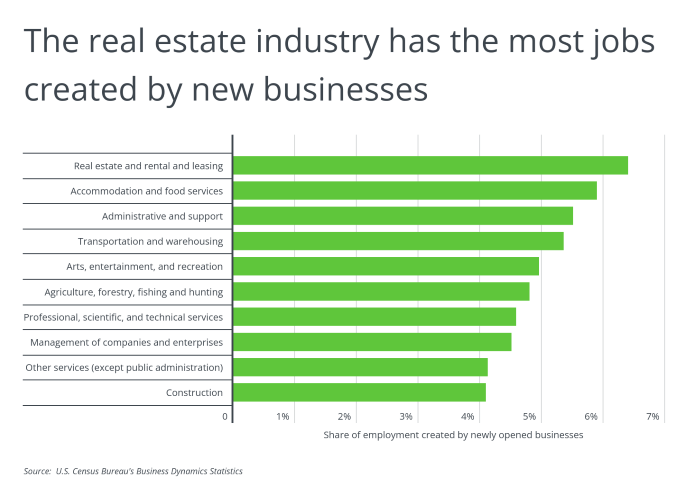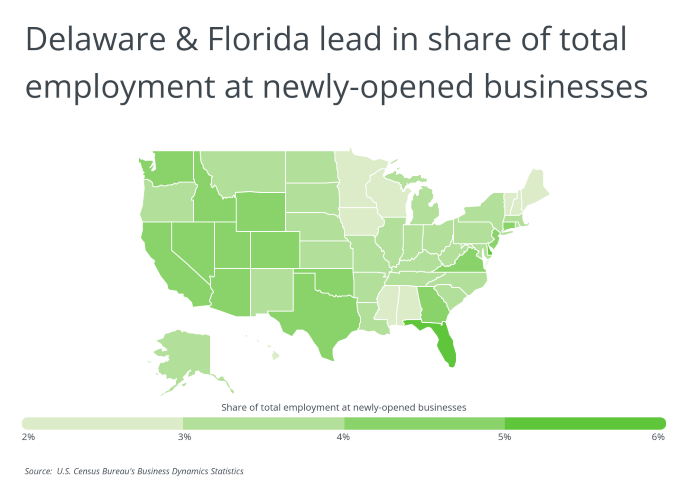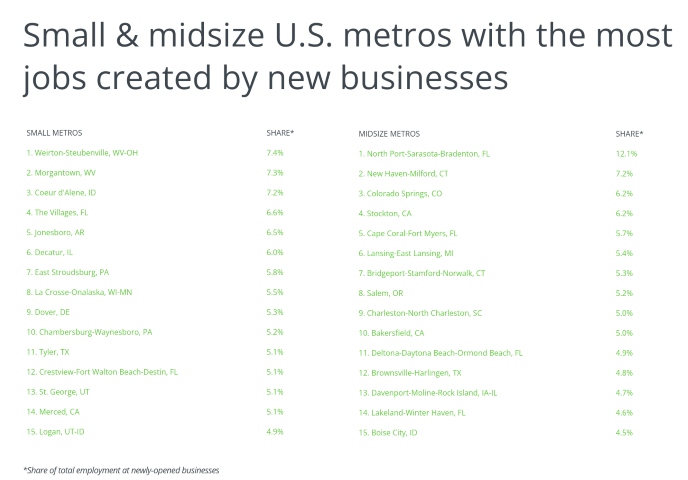Cities With the Most Jobs Created by New Businesses
 Photo Credit: fizkes / Shutterstock
Photo Credit: fizkes / Shutterstock
October 31st, 2022
One of the dominant trends in the U.S. economy in recent decades is the concentration of economic power in larger, established firms. Since the late 1970s, the share of startup firms in the economy has dropped from nearly 14% to just above 8% today. With fewer new businesses relative to established businesses, the U.S. economy loses out on the benefits that new businesses can provide, including innovation and economic dynamism.
Delaware leads all states with 5.6% of total employment at recently-opened businesses, which is likely attributable to the state’s business-friendly legal structures.
The power in older, larger firms also has implications for the labor market. A recent study from the U.S. Department of the Treasury reported that established firms hire fewer employees and pay wages roughly 20% lower than they would in a more competitive market. The concentration of power among larger firms also makes it more challenging for workers to move to new firms, which further impedes new business creation and growth.

These dynamics have made it more difficult for startup businesses to live up to their reputation as an engine of job creation. As larger firms' market power has grown, the share of jobs created by new businesses has fallen significantly. The share of total employment at newly-opened businesses neared 8% in the late 1980s, but today, new firms employ just 3.9% of the total labor market.

Certain industries see the effects of these trends more than others. New employers in utilities, manufacturing, and educational services generate less than 2% of total employment in those fields. These industries tend to have higher barriers to entry, making it harder for new businesses to get established and grow.
A recent study from the U.S. Department of the Treasury reported that established firms hire fewer employees and pay wages roughly 20% lower than they would in a more competitive market.
In contrast, the top industries generating jobs from new businesses include real estate (rental and leasing), accommodation and food services, administrative and support, waste management, and remediation services. New businesses are responsible for more than 5.5% of total employment in each of these industries.

In addition to varying by industry, job creation from new businesses also looks different across the country. Economic, demographic, and public policy differences across cities and states can create varying conditions for new businesses to thrive. For example, Delaware leads all states with 5.6% of total employment at recently-opened businesses, which is likely attributable to the state's business-friendly legal structures.
Other states that rank highly include Florida and Texas, which have growing populations and low tax rates that appeal to entrepreneurs, and California, which has a well-educated workforce and is a hotbed for startups in fast-growing technology fields. At the metro level, these three states together account for 10 of the top 15 cities with the most job creation from new firms.
The share of total employment at newly-opened businesses neared 8% in the late 1980s, but today, new firms employ just 3.9% of the total labor market.
The data used in this analysis is from the U.S. Census Bureau. To determine the locations with the most jobs created by new businesses, researchers at HireAHelper calculated the share of total employment attributable to business establishments that opened in the past 12 months. In the event of a tie, the location with the greater total employment at newly-opened businesses was ranked higher.
Here are the 15 U.S. metropolitan areas with the most jobs created by new businesses.

Large U.S. Metros With the Most Jobs Created by New Businesses
 Photo Credit: Sean Pavone / Shutterstock
Photo Credit: Sean Pavone / Shutterstock15. Dallas-Fort Worth-Arlington, TX
- Share of total employment at newly-opened businesses: 4.4%
- Total employment at newly-opened businesses: 152,206
- Share of total businesses that are newly opened: 11.0%
- Total newly-opened businesses: 17,199
 Photo Credit: Roschetzky Photography / Shutterstock
Photo Credit: Roschetzky Photography / Shutterstock14. Denver-Aurora-Lakewood, CO
- Share of total employment at newly-opened businesses: 4.5%
- Total employment at newly-opened businesses: 62,780
- Share of total businesses that are newly opened: 11.5%
- Total newly-opened businesses: 8,790
 Photo Credit: Jeremy Janus / Shutterstock
Photo Credit: Jeremy Janus / Shutterstock13. Seattle-Tacoma-Bellevue, WA
- Share of total employment at newly-opened businesses: 4.5%
- Total employment at newly-opened businesses: 81,256
- Share of total businesses that are newly opened: 10.1%
- Total newly-opened businesses: 9,659
 Photo Credit: Sean Pavone / Shutterstock
Photo Credit: Sean Pavone / Shutterstock12. Los Angeles-Long Beach-Anaheim, CA
- Share of total employment at newly-opened businesses: 4.5%
- Total employment at newly-opened businesses: 257,404
- Share of total businesses that are newly opened: 12.3%
- Total newly-opened businesses: 40,922
 Photo Credit: Just dance / Shutterstock
Photo Credit: Just dance / Shutterstock11. Miami-Fort Lauderdale-Pompano Beach, FL
- Share of total employment at newly-opened businesses: 4.6%
- Total employment at newly-opened businesses: 123,560
- Share of total businesses that are newly opened: 12.7%
- Total newly-opened businesses: 22,127
 Photo Credit: Sean Pavone / Shutterstock
Photo Credit: Sean Pavone / Shutterstock10. Houston-The Woodlands-Sugar Land, TX
- Share of total employment at newly-opened businesses: 4.6%
- Total employment at newly-opened businesses: 131,581
- Share of total businesses that are newly opened: 10.7%
- Total newly-opened businesses: 14,312
 Photo Credit: Jacob Boomsma / Shutterstock
Photo Credit: Jacob Boomsma / Shutterstock9. Fresno, CA
- Share of total employment at newly-opened businesses: 4.7%
- Total employment at newly-opened businesses: 13,842
- Share of total businesses that are newly opened: 9.6%
- Total newly-opened businesses: 1,530
 Photo Credit: Andrey Bayda / Shutterstock
Photo Credit: Andrey Bayda / Shutterstock8. Las Vegas-Henderson-Paradise, NV
- Share of total employment at newly-opened businesses: 4.7%
- Total employment at newly-opened businesses: 44,271
- Share of total businesses that are newly opened: 12.2%
- Total newly-opened businesses: 5,203
 Photo Credit: Songquan Deng / Shutterstock
Photo Credit: Songquan Deng / Shutterstock7. Orlando-Kissimmee-Sanford, FL
- Share of total employment at newly-opened businesses: 4.8%
- Total employment at newly-opened businesses: 57,801
- Share of total businesses that are newly opened: 12.3%
- Total newly-opened businesses: 7,539
 Photo Credit: Jon Bilous / Shutterstock
Photo Credit: Jon Bilous / Shutterstock6. Riverside-San Bernardino-Ontario, CA
- Share of total employment at newly-opened businesses: 4.8%
- Total employment at newly-opened businesses: 63,604
- Share of total businesses that are newly opened: 11.9%
- Total newly-opened businesses: 8,475
 Photo Credit: Bogdan Vacarciuc / Shutterstock
Photo Credit: Bogdan Vacarciuc / Shutterstock5. San Francisco-Oakland-Berkeley, CA
- Share of total employment at newly-opened businesses: 4.9%
- Total employment at newly-opened businesses: 118,203
- Share of total businesses that are newly opened: 10.4%
- Total newly-opened businesses: 12,458
 Photo Credit: Sean Pavone / Shutterstock
Photo Credit: Sean Pavone / Shutterstock4. Oklahoma City, OK
- Share of total employment at newly-opened businesses: 5.0%
- Total employment at newly-opened businesses: 28,023
- Share of total businesses that are newly opened: 9.5%
- Total newly-opened businesses: 3,097
 Photo Credit: Roschetzky Photography / Shutterstock
Photo Credit: Roschetzky Photography / Shutterstock3. Austin-Round Rock-Georgetown, TX
- Share of total employment at newly-opened businesses: 5.1%
- Total employment at newly-opened businesses: 47,157
- Share of total businesses that are newly opened: 12.0%
- Total newly-opened businesses: 6,172
 Photo Credit: Sean Pavone / Shutterstock
Photo Credit: Sean Pavone / Shutterstock2. Nashville-Davidson-Murfreesboro-Franklin, TN
- Share of total employment at newly-opened businesses: 5.3%
- Total employment at newly-opened businesses: 49,859
- Share of total businesses that are newly opened: 9.7%
- Total newly-opened businesses: 4,087
 Photo Credit: CHARLES MORRA / Shutterstock
Photo Credit: CHARLES MORRA / Shutterstock1. Jacksonville, FL
- Share of total employment at newly-opened businesses: 6.7%
- Total employment at newly-opened businesses: 43,541
- Share of total businesses that are newly opened: 11.4%
- Total newly-opened businesses: 4,026
Detailed Findings & Methodology
The data used in this analysis is from the U.S. Census Bureau's Business Dynamics Statistics 2020 datasets. To determine the locations with the most jobs created by new businesses, researchers at HireAHelper calculated the share of total employment attributable to business establishments that opened in the past 12 months. A business establishment is defined as a single physical location where one predominant business activity occurs and businesses may have multiple establishments. In the event of a tie, the location with the greater total employment at newly-opened businesses was ranked higher. To improve relevance, only metropolitan areas with at least 100,000 residents were included. Additionally, metros were grouped into cohorts based on population size: small (100,000–349,999), midsize (350,000–999,999), and large (1,000,000 or more).